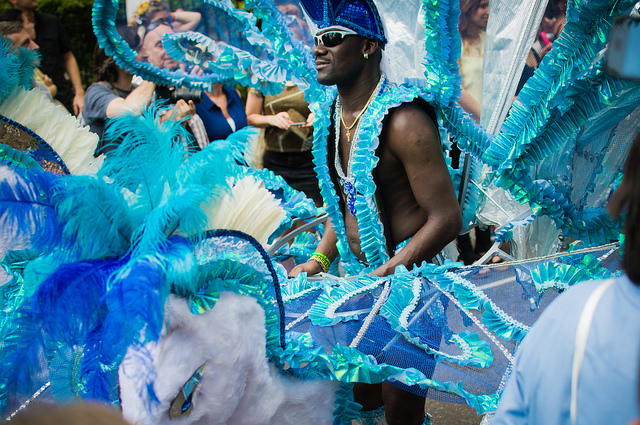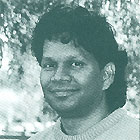Notting Hill Carnival
Professor David Dabydeen, Yesu Persaud Centre for Caribbean Studies
Published August 2010
The Notting Hill Carnival is almost fifty years old this bank holiday. The Carnival generally attracts around one million people over the two-day event making it one the biggest street festivals in the world. This area of West London became home to a Trinidad and Tobago Caribbean population in the 1950s and the Notting Hill event follows in the traditions of the Carnival held in the Caribbean country each springtime.

Professor David Dabydeen, former Director of The Yesu Persaud Centre for Caribbean Studies, explained: “It came out of the French colonisation and their Catholic traditions. Slaves masqueraded as the master or mistress of the plantation; they would put on a white mask and hold a whip.”
Playing out these fantasies was more than just a vent of frustrations: “It explicitly undermined the idea of the master by focusing on the cruelty and the sexual debauchery. But it was also subversive in a more subtle way: by becoming a master in your own mind you are closing the gap between what a slave is and what a master is and ultimately this resulted in the struggle for freedom.”
Mas' or masquerade is still one of the central disciplines that play out at the Carnival; the others include Steelband, Calypso (political, social and satirical commentary, set to music), Soca (the traditional music of Carnival, a fusion of Soul and Calypso), Static Sound Systems, and Samba. The distinctive Caribbean flavour of the event means, for Prof Dabydeen, that the roots of Carnival in Britain are often overlooked: “Carnival is not alien to British culture. Bartholomew Fair and Southwark Fair in the 18th century were moments of great festivity and release. There was juggling, pickpocketing, whoring, drinking, masquerade - people dressed up as the Archbishop of Canterbury and indulged in vulgar acts, for example. It allowed people a space to free-up but it was banned for moral reasons and for the antiauthoritarian behaviour that went on like stoning of constables.
“Notting Hill Carnival single-handedly revived this tradition and is a great contribution to British cultural life. When West Indian immigrants came to Britain by invitation, post-war, to work in the factories and hospitals - the grey areas - having Carnival allowed them to imagine a different world that was not grey, low skied, cold and racist.”
Previously media-focus on violence that went on at the Notting Hill Carnival threatened to mar the reputation of the event: “Physical violence was part of Carnival. If you look at Hogarth’s prints of the fairs there was violence against the state then.” Prof Dabydeen argues that the violence is aggravated, not stopped, by aggressive police action: “Carnival allows people to dramatise their grievances against the authorities on the street, when Parliament or other spaces of influence are closed off to them. Of course rioting is an ancient British practice, from the Peasants' Revolt onwards. Violence only occurs when the authorities try to 'mash you up' - when the practice of ‘stop and search’, which demonised black British youth was ended, the violence at the Carnival calmed down. Notting Hill has a non-violent ideology now. There are alternative peaceful and creative ways of protest.”
Since the Carnival began in the 1960s, race relations in Britain have moved on: “Riot and protest at the Carnival, oddly enough, had a positive impact on the relationship between black people and the state. The state recognised that black people had grievances - the Macpherson Report (1999), the Scarman Report (1981), they all acknowledged institutional racism and the need to do something about it.” But does the acceptance and celebration of the Notting Hill Carnival mark the end of a need to question the representation of black people in Britain? “Institutional racism, conscious or unconscious, still exists. The University of Warwick has made symbolic, and important gestures to be more international - we have a Centre for Caribbean Studies, and a previous Chancellor, Sir Shridath Ramphal, is a Guyanese - many institutions have not gone that far. Many universities are far from being ‘universal’, in terms of the extreme paucity of academic staff from Africa or the Caribbean. In other areas of public life you do not see people of colour. We need an intellectual, imaginative Carnival to challenge this.”
 David Dabydeen is a Professor at the Yesu Persaud Centre for Caribbean Studies at the University of Warwick. He has co-edited The Oxford Companion to Black British History (2007) and published in 2008 his sixth novel, Molly and the Muslim Stick (Macmillan). He is working on a neglected 19th Century Caribbean poet, Egbert Martin. His novel Our Lady of Demarara was published in 2004. He was Consultant to Channel 4's three-part series on interracial sex, Forbidden Fruit, which was broadcast in 2003. His one-hour documentary Painting the People was broadcast by BBC television in 2004. He was awarded the 2004 Raja Rao Award for literature. He is Guyana's Ambassador and Permanent Delegate to UNESCO.
David Dabydeen is a Professor at the Yesu Persaud Centre for Caribbean Studies at the University of Warwick. He has co-edited The Oxford Companion to Black British History (2007) and published in 2008 his sixth novel, Molly and the Muslim Stick (Macmillan). He is working on a neglected 19th Century Caribbean poet, Egbert Martin. His novel Our Lady of Demarara was published in 2004. He was Consultant to Channel 4's three-part series on interracial sex, Forbidden Fruit, which was broadcast in 2003. His one-hour documentary Painting the People was broadcast by BBC television in 2004. He was awarded the 2004 Raja Rao Award for literature. He is Guyana's Ambassador and Permanent Delegate to UNESCO.
Image: Blue is the Colour by A Pillow of Winds (via Flickr)
